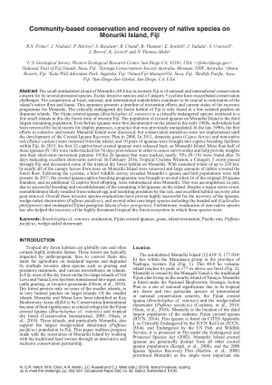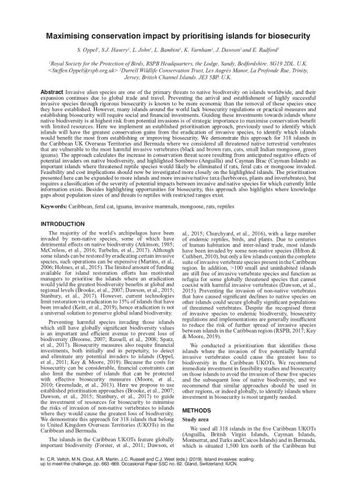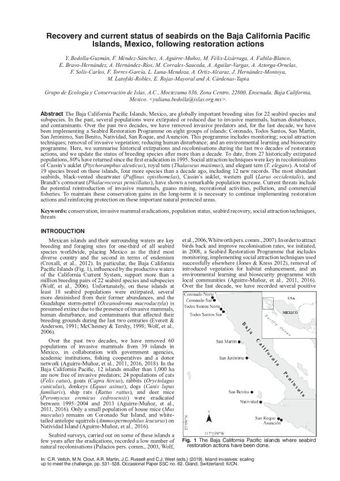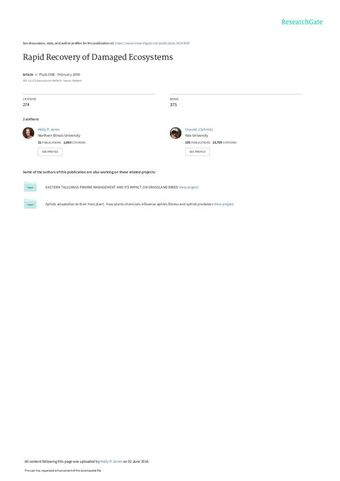Community-based conservation and recovery of native species on Monuriki Island, Fiji
- Description:
- The small uninhabited island of Monuriki (40.4 ha) in western Fiji is of national and international conservation concern for its several protected species. Exotic invasive species and a Category 5 cyclone have exacerbated conservation challenges. The cooperation of local, national, and international stakeholders continues to be crucial in restoration of the islands native ?ora and fauna. This summary presents a timeline of restoration efforts and current status of the recovery programme for Monuriki. The critically endangered dry forest habitat of Fiji is only found in a few isolated patches on disparate islands. The Fijian crested iguana (Brachylophus cf. vitiensis) is a critically endangered species restricted to a few small islands in this dry forest zone of western Fiji. The population of crested iguanas on Monuriki Island is the third largest remaining population. Even before iguanas were ?rst documented on the island in the early 1980s, individuals had been removed by local resorts for display purposes, a practice that was previously unregulated. In the late 1990s, the ?rst efforts to conserve and restore Monuriki Island were discussed, but conservation initiatives were not implemented until the development of the Crested Iguana Recovery Plan in 2008. In 2011, domestic goats (Capra hircus) and non-native rats (Rattus exulans) were removed from the island, and 10 pairs of iguanas were brought into captive breeding facilities within Fiji. In 2015, the ?rst 32 captive-bred crested iguanas were released back on Monuriki Island. More than half of these iguanas (N=26) were radio-tracked for 56 days post-release in order to assess survivorship and help provide insights into their short-term movement patterns. Of the 26 iguanas that were tracked, nearly 70% (N=18) were found after 56 days indicating excellent short-term survival. In February 2016, Tropical Cyclone Winston, a Category 5 storm passed through Fiji and devastated some of the tropical dry forest habitat on Monuriki. With sustained winds of up to 230 km/ hr nearly all of the canopy leaves from trees on Monuriki Island were removed and large amounts of debris covered the forest ?oor. Following the cyclone, a brief wildlife survey revealed Monurikis iguana and bird populations were still present. In 2017, the crested iguana captive breeding programme was brought to an end when 16 of the original 20 iguana founders, and an additional 32 captive bred o? spring, were reintroduced onto Monuriki. This was accomplished, in part, due to successful breeding and reestablishment of the remaining wild iguanas on the island. Despite a major storm event, reestablishment likely resulted from reduced egg and hatchling predation by the rats, and excellent habitat recovery after goat removal. Overall these invasive species eradications have proven highly successful for the recovery of the iguanas, wedge-tailed shearwaters (Puffinus paci?cus), and several other non-target species including the banded rail (Gallirallus philippensis) and endangered Fijian peregrine falcon (Falco peregrinus). Furthermore, eradication of non-native species has also helped the recovery of the highly threatened tropical dry forest ecosystem in which these species exist.
- Display date:
- 2019
- Location:
- Fiji
- Collections:
- Secretariat of the Pacific Regional Environment Programme (SPREP)
- Publisher:
- International Union for Nature Conservation (IUCN)
- Content partner:
- Secretariat of the Pacific Regional Environment Programme (SPREP)
- Availability:
- Not specified
-
Copyright status: All rights reservedFind out more about what you are able to do with this itemThis item is all rights reserved, with means you'll have to get permission from Secretariat of the Pacific Regional Environment Programme (SPREP) before using it. For more information, please see our use and reuse page.What can I do with this item?Non-infringing useNZ copyright law does not prevent every use of a copyright work, and this item may be hosted by an international institute or organisation. You should consider what you can and cannot do with a copyright work.No sharingYou may not copy and/or share this item with others without further permission. This includes posting it on your blog, using it in a presentation, or any other public use.No modifyingYou are not allowed to adapt or remix this item into any other works.No commercial useYou may not use this item commercially.
Related items
Welcome and warm Pasifik greetings
The information on this site has been gathered from our content partners.
The names, terms, and labels that we present on the site may contain images or voices of deceased persons and may also reflect the bias, norms, and perspective of the period of time in which they were created. We accept that these may not be appropriate today.
If you have any concerns or questions about an item, please contact us.



